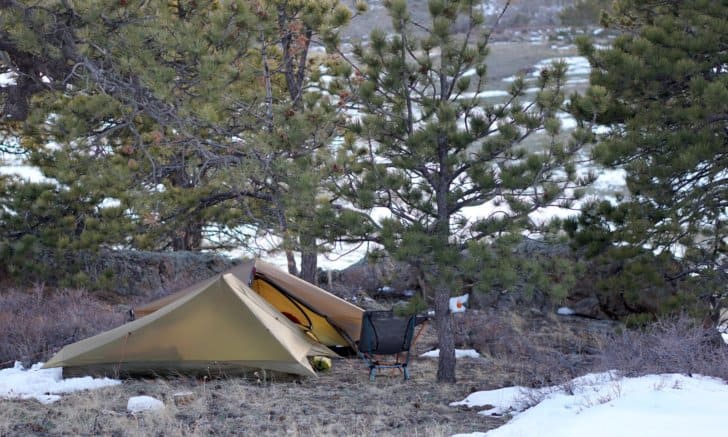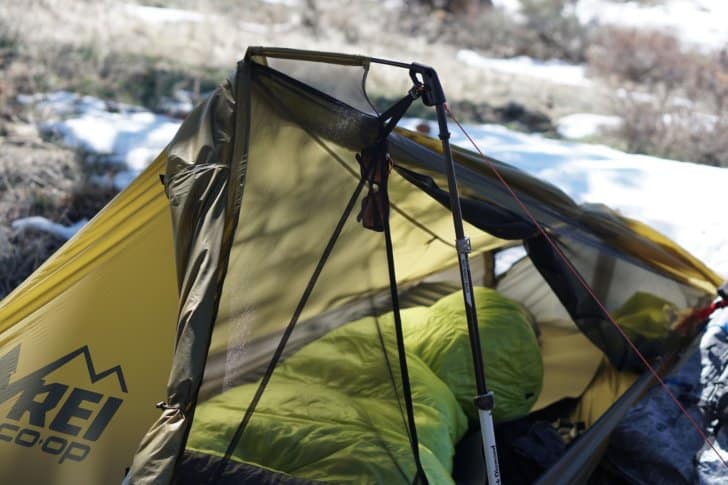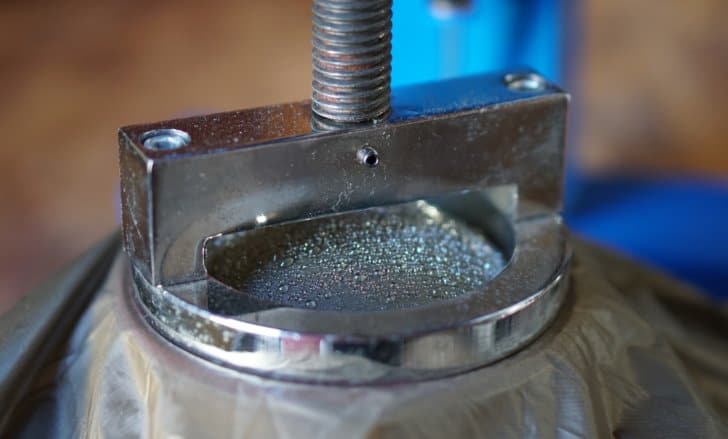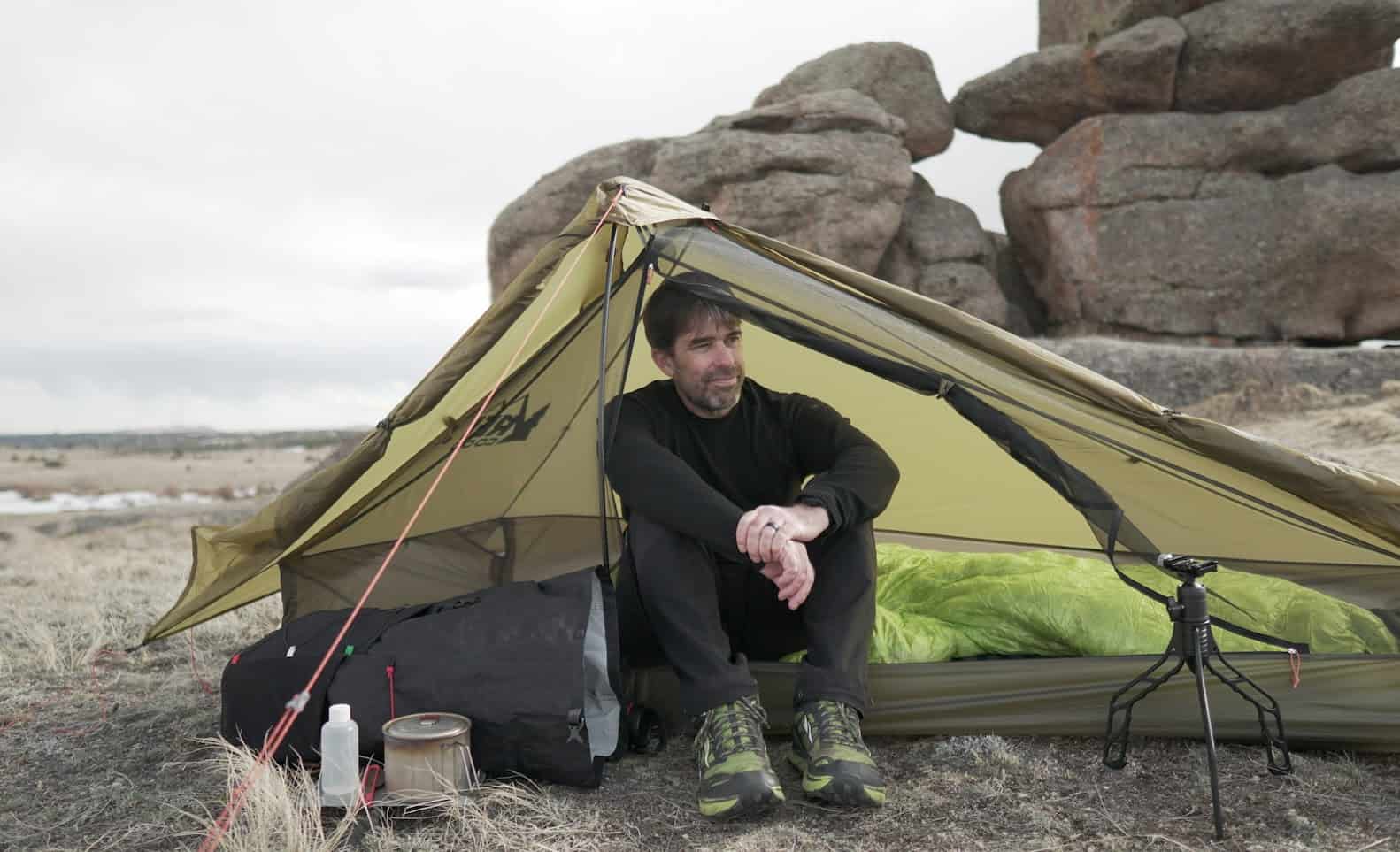Introduction
The REI Flash Air 1 Tent (20 oz / 567 g, $249) is a hybrid single/double-wall solo tent with a single entrance and vestibule and can be supported by a single trekking pole. A 2-person model is also available (the REI Flash Air 2 Tent, 31 oz / 879 g, $299).

About This Review
This Limited Review is based on overnight backcountry use in a single geographic environment (the mountains near southeast Wyoming). The tent has been exposed to light rain and snowfall, mild-to-moderate winds, overnight temperatures near freezing, and moderate humidity levels. In addition, I performed a quantitative condensation study and a direct measurement of the hydrostatic head rating (waterproofness) of the fly fabric using a Suter tester. This review builds on the initial peek at this product as published in our First Looks of the REI Flash Air 1 Tent.

Features & Specifications
- key features
- non-freestanding (requires a minimum of 5 stakes)
- no. of accessory guyline tie-out points: 8
- no. of included extra guylines: 4
- weight
- claimed (tent body, strut, and roof pole): 20 oz (567 g)
- measured (tent body, strut, and roof pole): 20.10 oz (570 g)
- measured weight of included vertical pole (required if a trekking pole isn’t used): 1.72 oz (49 g)
- dimensions
- floor: 88×35/27 in / 224×90/69 cm (LxW head/foot)
- surface area
- floor: 21.3 sq. ft. (1.98 sq. m.)
- vestibule: 8.4 sq. ft. (0.78 sq. m.)
- materials
- support pole (optional, or use a trekking pole): DAC Featherlite NFL Green, 9.3 mm dia x 38 in (96.5 cm), 3-sections fold to 14 in (35.6 cm)
- end strut pole: 8.7 mm dia x 11.875 in (30.2 cm)
- roof pole: 8.7 mm dia x 14 in (35.6 cm)
- roof pole hub: molded plastic
- fly and floor: ripstop nylon
- mesh: nylon noseeum mesh
- MSRP: $249

Performance
Because this is a Limited Review, a detailed performance analysis based on long-term testing will not be presented. In lieu of a detailed analysis, performance observations and issues are noted below.
Before reviewing the table below in detail, take a look at my initial First Looks video about the REI Flash Air 1 Tent that I posted in my First Looks Review, which also addresses some questions from our forum community:

| Criteria | Observations and Issues |
|---|---|
| ease of setup | No issues of note - setup is fast, simple, and intuitive; the instructions are worth reading, just to familiarize yourself with how the roof hub pole assembly works with the included vertical pole vs. a trekking pole. Because the shelter depends on the balance of tension around its perimeter, it's easy to overtighten guylines attached to the fly. |
| quality of materials and construction | Consistent with other tents we've reviewed from REI, and similar to the REI Quarter Dome SL1 and REI Quarter Dome SL2. Seams, cut-and-sew quality, and seam taping are all performed to a consistently high standard, on par with shelters from MSR and Big Agnes. |
| livability | The REI Flash Air 1 Tent is small - more in line with a solo bivy tent than a solo tent you'd want to spend extended time in during an all-day rainstorm. Its Achilles' heel is its interior height at the ends, which limits the overhead volume in the tent that's required for anyone larger than an average-sized man to move around much, change clothes, etc. Design execution using the roof "arch" pole combined with a trekking pole and fabric tension from stake-out points is brilliant - it works and adds meaningful headroom. |
| rain protection | The vertical mesh inner tent door is protected by the fly during an overhead rain. The fly and floor fabrics tested to about 1,800 mm H2O on my (calibrated) Suter tester. This is sufficient for moderate rain protection, but water may seep through this ultralight floor material if you camp on hard, sopping wet ground, and crawl around on your knees in the tent. |
| snow loading | This is an ultralight tent that loses volume in response to very light snow loading. Given this limitation, it probably can't be considered a 3-season tent for some users. |
| ventilation/condensation resistance | Two very small vents at either end and a vestibule door that sits a few inches above the ground provide intake points for dry air, while a full mesh wall and peak vent allow moist air to escape. However, by nature of its hybrid-wall design and small interior volume, this is not a tent for sustained cold, humid conditions. End and back walls are solid and joined to the floor, so provide no place for dripping condensation to escape tent without reaching the floor. |
| warmth | Hybrid wall design doesn't provide meaningful insulation to allow tent to retain much body heat at night. |
| compressibility | Ultralight fabrics are very compressible, and pole sections are minimal, short, and easily separable from the body. |
| aesthetics | Foremost, I absolutely love the drab olive color. It disappears into the landscape, making it almost as non-intrusive as my favorite tent color, Hilleberg Sand. The profile is low, the lines are clean, and the pattern cuts make it look kind of like a Stealth Bomber. It's a cool design, and it's not ugly! |
| value | At $249, the REI Flash Air 1 Tent is a quality product that provides a light, minimalist shelter for a range of conditions that doesn't include extended heavy rain or cold, humid environments. |

Commentary
What makes the REI Flash Air 1 Tent Unique?
There are lighter shelters that offer more volume than the REI Flash Air 1, but they are usually made from exotic materials like Dyneema Composite Fabrics and cost twice as much or more.
There are more compact fully-enclosed shelters at close to the same weight and cost (e.g., hooped bivy sacks), but they lack livability and wet-entry-and-exit options.
Therefore, the unique aspect of the REI Flash Air 1 Tent is its combination of:
- low weight
- low packed volume
- reasonable price point
Hydrostatic Head Test
I used a Suter tester (calibrated) to measure the hydrostatic head rating of the REI Flash Air 1 Tent fly and floor fabrics. Both measurements were similar – about 1,800 mm H2O of pressure was required for water droplets to begin appearing at the ripstop threads. Read Roger’s account of this particular phenomenon in his article about hydrostatic head testing.

This compares well with some other ultralight fabrics I’ve tested. For example, the fabric used in The One by Gossamer Gear tests at around 1,300 mm H2O on my test device. For context, Tarptent silnylons (latest generation) test at around 3,500 mm H2O, and Hilleberg Kerlon 1000 tests well over 5,500 mm H2O. Note: all of these numbers represent new fabrics that haven’t yet been exposed to significant amounts of UV radiation from sunlight.
Condensation Resistance and Livability
The REI Flash Air 1 tent’s most notable limitations include its condensation resistance and its livability.
I’ve addressed both in detail in this video:

Here’s a graph showing its temperature and condensation performance (as measured with Kestrel Drop meters placed inside and outside the tent) on a cold, clear night at an elevation of 7,800 feet (2,377 m) in southeast Wyoming (click image for larger size):
Points of interest on the graph:
- A
- Bedtime – I enter the tent, close the roof vent (just for fun), and zip up the doors.
- Increase in inside temp and humidity results from me moving around lot as I changed clothes and wriggled into my sleeping bag.
- B
- I’m in my sleeping bag here and now remain still, so the environment starts to stabilize.
- Inside humidity begins to drop to around 65%, where it reaches a pseudo-equilibrium with the outside environment.
- Outside air temp is 39 F and outside RH is 53%. Inside air temp is 39 F and inside RH is 65%. Inside vapor pressure differential is 2.88 mb (see the Tarptent Moment DW review for details about this calculation and why it’s important).
- Note throughout this test that inside and outside temperatures are nearly the same, reflecting the tent’s lack of insulating ability.
- Nothing more than a thin film of very light condensation is observed on the tent walls until about midnight.
- C
- At midnight, outside temp takes a sharp dive of a few degrees, while outside humidity increases by about 10%.
- Inside humidity increases significantly now, approaching 95%+ for the next several hours. Inside vapor pressure differential is now only 0.25 mb.
- Condensation begins to accumulate on the tent walls. By 4 am, there are visible drops of condensation.
- D
- I have to pee at 4:30 am.
- Wriggling around raises the inside temperature as I get ready for nature’s call.
- When I return to bed, I open to the foot-end vestibule door, and roll it all the way back, exposing half the sidewall and the lower roof mesh to open air.
- The humidity inside the tent drops from 97% to 70% and stays steady at 70% until sunrise. Inside vapor pressure differential rises to 1.48 mb by 6:00 am.
- Condensation inside the tent gradually disappears over the next few hours.
- E
- Official sunrise, 6:15 am.
- By 6:45 (when the sun’s first direct rays hit my tent), there is virtually no condensation remaining in the tent, except very a very thin, almost imperceptible film on the roof; vapor pressure differential inside tent here is calculated to be 5.79 mb.
- F
- 8:00 am, I’m awake for the day.
- The sun is beating down on my tent and the interior temp climbs into the 80s.
Compared To…
The REI Flash Air 1 Tent is a single-entry, single-vestibule, side-entry, solo tent that can be pitched with a single trekking pole and weighs only 20 oz (567 g).
You simply cannot find any shelters that offer this feature set, at this weight, and at this cost.
If we are to compare tents of similar cost, they will be notably heavier, as a result of heavier fabrics, more features, more volume, or more pole structure. For example, the Six Moon Designs Skyscape and the Tarptent Notch offer two entrances, two vestibules, and require two trekking poles, at weights at least 8 oz (227 g) heavier than the REI Flash Air 1 Tent. Likewise, similar weights are available for solo, side-entry, 1-entrance/vestibule tents with their own pole sets, like the REI Quarter Dome SL 1.
And, if you look at single-trekking pole side-entry tents like the Tarptent Aeon Li or the ZPacks Plexamid, you’re now into a weight range that’s more competitive, but they are made with Dyneema Composite Fabrics that drive the price to more than twice the price of the REI Flash Air 1. Now, if you consider something like The One from Gossamer Gear, you have a shelter that is close in design and weight to the REI Flash Air 1 Tent. The key difference is that The One uses two trekking poles. It’s a little bit larger shelter, but also a little more expensive than the REI Flash Air 1 Tent.
Scroll right to view additional table columns.
| REI Flash Air 1 | Six Moon Designs Skyscape Trekker | Tarptent Notch | REI Quarter Dome SL 1 | Tarptent Aeon Li | ZPacks Plexamid | Gossamer Gear The One | |
|---|---|---|---|---|---|---|---|
| weight (minimum) | 20 oz | 28 oz | 27 oz | 29 oz | 16 oz | 15 oz | 21 oz |
| MSRP | $249 | $250 | $314 | $299 | $535 | $549 | $299 |
| wall type | hybrid | hybrid | double | double | hybrid | hybrid | hybrid |
| # trekking poles required to pitch | 1 | 2 | 2 | 0 | 1 | 1 | 2 |
| # entrances/vestibules | 1 | 2 | 2 | 1 | 1 | 1 | 1 |
| fly fabric | nylon | silpoly | silnylon | nylon | DCF | DCF | sil/PU nylon |
| peak height | 42 in | 45 in | 42 | 38 in | 47 in | 48 in | 46 in |
| floor area | 21.3 sq. ft. | 23.0 sq. ft. | 15.8 sq. ft. | 18.9 sq. ft. | 18.3 sq. ft. | 20.6 sq. ft. | 18.3 sq. ft. |
| vestibule area | 8.4 sq. ft. | 16 sq. ft. | 16 sq. ft. | 9.6 sq. ft. | 8.6 sq. ft. | 6.4 sq. ft. | 16.2 sq. ft. |
Strengths
- Core function – minimalist, overhead shelter with a side-entry and a reasonably generous vestibule – is very high for a tent at this weight and price point.
- Easy to set up, with very little fiddle factor.
- Ventilation and views are outstanding in fair weather. It’s a good option for buggy, warm conditions.
- REI product that comes with outstanding customer service and a solid warranty.
Limitations
- Limited weather resistance – this isn’t a tent for snow or high winds.
- Limited condensation resistance – this isn’t a tent for cold, humid environments.
- Limited livability – small volume isn’t ideal for larger folks or if you have to spend a few days holed up in a rainstorm.
Where to Buy
Related Content
- Learn how we relate vapor pressure differential to condensation observations in our Tarptent Moment DW Review.
- We address the quality of REI’s other ultralight tents more specifically in our reviews of the REI Quarter Dome SL 1 and REI Quarter Dome SL 2 tents.
- Our review of the Tarptent Aeon Li features a single-side entry, single-vestibule, 1-trekking pole hybrid-wall tent that may be the performance gold standard for this style of shelter.
DISCLOSURE (Updated April 9, 2024)
- Product mentions in this article are made by the author with no compensation in return. In addition, Backpacking Light does not accept compensation or donated/discounted products in exchange for product mentions or placements in editorial coverage.
- Some (but not all) of the links in this review may be affiliate links. If you click on one of these links and visit one of our affiliate partners (usually a retailer site), and subsequently place an order with that retailer, we receive a commission on your entire order, which varies between 3% and 15% of the purchase price. Affiliate commissions represent less than 15% of Backpacking Light's gross revenue. More than 70% of our revenue comes from Membership Fees. So if you'd really like to support our work, don't buy gear you don't need - support our consumer advocacy work and become a Member instead.
- Learn more about affiliate commissions, influencer marketing, and our consumer advocacy work by reading our article Stop wasting money on gear.





Home › Forums › REI Flash Air 1 Tent Review